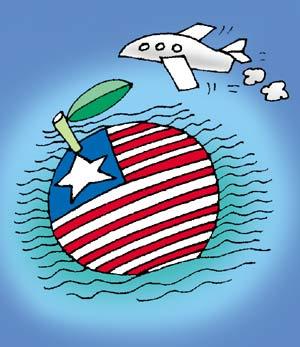 | « Back to article | Print this article |
Number of Indians studying in the US drops yet again
For the second successive year, the number of Indian students in the US drops; China leads among the countries that send its students to the US for studies.
While the number of international students at colleges and universities in the United States increased by six per cent to a record high of 7,64,495 in the academic year 2011-12, the number of Indian students in the US dropped nearly four per cent compared to the previous year, according to the 2012 Open Doors Report on International Education Exchange.
The Institute of International Education publishes the report annually in partnership with the US Department of State's Bureau of Educational and Cultural Affairs.
Marking a decline for the second consecutive year, India, which had been the leading place of origin for international students in the US from 2001-02 through 2008-09, ceded the leadership to China once again sending 1,00,270 students or 13.1 per cent to China's 1,94, 029 students or 25.4 per cent of the total.
So, while the number of Chinese students in the US increased by 23.1 per cent, the number of Indian students decreased by 3.5 per cent from the previous year.
In 2010-11, out of a total of 7,23,277 China sent 1,57,558 students for study in the US, while India's total was 1,03, 895.
It was in 2000-01 when there was a surge in enrolments from India, with an increase of 30 per cent, followed by two more years of strong growth -- 12 per cent in 2002-03 and 7 per cent in 2003-04.
The increases tapered off in 2004-05 and then decreased slightly in 2005-06.
In 2006-07 however, the number increased as India sent 83,833 students to study in the US and 94,563 students in the following year.
India hit the 1,00,000 mark for the first time in 2008-09 when 1,03,260 students went to study in the US and topped it in 2009-10 with 1,04, 897, which was the highest number of students India had sent to the US in any given year.
After 2009-10, the increases levelled out and China became the top sender and has remained in that position.
Unlike China, from where majority of students visiting the US were for undergraduate studies, their Indian counterparts came in droves for their post-graduation programmes.
In 2011-12, the breakdown was as follows: Undergraduate students: 13 per cent, graduate students: 58.9 per cent, other: 1.5 per cent and Optional Practical Training; 26. 7 per cent.
This year, according to Open Doors, international exchanges in all 50 states had contributed $22.7 billion to the US economy.
Besides China, there were increases in the number of students from 12 of the top 25 places of origin, including Brazil, France, Indonesia, Iran, Mexico, Russia, Saudi Arabia, Spain, the United Kingdom, Venezuela and Vietnam.
At the same time, numbers declined from several major sending countries led by India, and including South Korea (down by one per cent) and Japan (down six per cent).
According to IIE, 'the factors driving these declines may include global and home country economic factors, growing higher education opportunities at home, and stronger employment opportunities at home after graduation'.
Speaking at the roll-out of the report at the National Press Club in Washington, DC, Ann Stock, Assistant Secretary of State for Educational and Cultural Affairs said, "Today's youth are tomorrow's leaders. International education creates strong, lasting relationships between the US and emerging leaders worldwide."
"Students return home with new perspectives and a global skill set that will allow them to build more prosperous, stable societies," she added.
Number of Indians studying in the US drops yet again
President and CEO of Institute of International Education, Allen E Goodman said, "Academic and intellectual exchange fuels innovation and prepares the next generation for global citizenship," and pointed out, "Today's students will become future business and government leaders whose international experience will help them to build a prosperous and more peaceful world."
According to IIE, the strong increase in international student enrolments showed the continued conviction of international students -- and parents -- that a US degree 'is a sound investment in their future careers'.
It said this finding was reinforced by results of recent IIE surveys of students overseas considering studying outside their own countries.
The IIE said the 2011-12 data marked the sixth consecutive year that Open Doors had reported expansion in the total number of international students in US higher education.
There were 31 per cent more international students studying at US colleges and universities than there were a decade ago.
"A similar increase in the number of 'new' international students -- those enrolling for the first time at a US college of university -- in fall 2012, indicates that this growth trend is continuing," it said.
However, the IIE acknowledged that despite this strong growth, international students still constituted less than four per cent of the total of US higher education enrolment.
While Chinese student enrolments increased by 23 per cent in total and by 31 per cent at the undergraduate level, the Institute noted that 'large increases in undergraduate students from Saudi Arabia, funded by Saudi government scholarships also explain why international graduates studying in the Unites States now outnumber international graduate students, for the first time in 12 years'.
Open Doors 2012 reported that more than 70 per cent of all international students received the majority of their funds from sources outside of the United States, including personal and family sources as well as assistance from their home country governments or universities.
The IIE and the Department of State reiterated that 'students from around the world who study in the United States also contribute to America's scientific and technical research and bring international perspectives into US classrooms, helping prepare American undergraduates for global careers, and often lead to longer-term business relationships and economic benefits'.
The report said that the increased international presence had been felt across the United States, with the top 20 host universities and nine of the top 10 host states with more international students than in the prior year.
California led the way, hosting more than 100,000 international students for the first time this year, followed by New York, Texas, Massachusetts and Illinois. Among the top 10 destinations, Pennsylvania, Florida and Indiana had the largest per cent increases, with the international student population in each state growing by close to 10 per cent.
At the institutional level, the University of Southern California had the greatest number of international students, followed by University of Illinois at Urbana-Champaign, New York University, Purdue University and Columbia University. New York City remained the top metropolitan area for international students.
The top field of study for international students in 2011-12 was business and management followed by engineering, math and computer sciences and physical and life sciences.
Meanwhile academic year in 2010-11, 2,73,996 American students studied abroad for academic credit, an increase of one per cent -- an all-time high and US students studying abroad increased in 17 of the top destination countries.
Five per cent more students studied in China and 12 per cent more students studied in India that in the prior year -- from 3,884 to 4,345.
But the increase from 2008-09 to 2009-10, from 2,690 to 3,884 was an increase of 44.4 per cent.
The United Kingdom remained the leading destination for American students, followed by Italy, Spain, France and China -- which remained the fifth largest host destination for the fifth year.
There were also significant increases in the number of Americans studying in several 'non-traditional' destinations outside Europe -- Brazil, China, Costa Rica, India and South Korea. In 2010-11, India was 11th in the pecking order.

